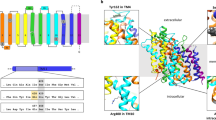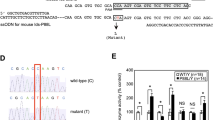Abstract
Sialidase (neuraminidase, EC 3.2.1.18) catalyses the hydrolysis of terminal sialic acid residues of glyconjugates. Sialidase has been well studied in viruses and bacteria where it destroys the sialic acid-containing receptors at the surface of host cells1–3, and mobilizes bacterial nutrients4. In mammals, three types of sialidases, lysosomal, plasma membrane and cytosolic, have been described5,7. For lysosomal sialidase in humans, the primary genetic deficiency results in an autosomal recessive disease, sialidosis, associated with tissue accumulation and urinary excretion of sialylated oligosaccharides and glycolipids. Sialidosis includes two main clinical variants: late-onset, sialidosis type I, characterized by bilateral macular cherry-red spots and myoclonus8,9, and infantile-onset, sialidosis type II, characterized by skeletal dysplasia, mental retardation and hepatosplenomegaly10–12. We report the identification of human lysosomal sialidase cDNA, its cloning, sequencing and expression. Examination of six sialidosis patients revealed three mutations, one frameshift insertion and two missense. We mapped the lysosomal sialidase gene to human chromosome 6 (6p21.3), which is consistent with the previous chromosomal assignment of this gene in proximity to the HLA locus.
This is a preview of subscription content, access via your institution
Access options
Subscribe to this journal
Receive 12 print issues and online access
$209.00 per year
only $17.42 per issue
Buy this article
- Purchase on Springer Link
- Instant access to full article PDF
Prices may be subject to local taxes which are calculated during checkout
Similar content being viewed by others
References
Hirst, G.K. The agglutination of red cells by allantoic fluid of chick embryos infected with influenza virus. Science 94, 22–23 (1941).
Gottschalk, A. & Lind, P.E. Product of interaction between influenza virus enzyme arid ovomucin. Nature 164, 232–233 (1949).
Galen, J.E. et al. Role of Vibrio cholerae neuraminidase in the function of cholera toxin. Infect. immun. 60, 406–415 (1992).
Corfield, T. Bacterial sialidases—roles in pathogenicity and nutrition. Glycobiology 2, 509–521 (1992).
Verheijen, F.W. et al. Two genetically different mu-nana neuraminidases in human leucocytes. Biochem. Biophys. Res. Commun. 117, 470–478 (1983).
Miyagi, T. Sagawa, J. Konno, K. & Tsuiki, S. Immunological discrimination of intralysosomal, cytosolic, and two membrane sialidases present in rat tissues. J. Biochem. 107, 794–798 (1990).
Schneider-Jakob, H.R. & Cantz, M. Lysosomal and plasma membrane ganglioside GM3 sialidases of cultured human fibroblasts. Differentiation by detergents and inhibitors. Biol. Chem. Hoppe-Seyler 372, 443–450 (1991).
Durand, P. et al. Sialidosis (mucolipidosis I). Helv. Paedia. Acta 32, 391–400 (1977).
O'Brien, J.S. The cherry-red spot-myoclonus syndrome: a newly recognized inherited lysosomal storage disease due to acid neuraminidase deficiency. Clin. Genet. 14, 55–60 (1979).
Till, J.S. Roach, E.S. & Burton, B.K. Sialidosis (neuraminidase deficiency) types I and II: neuro-opthalmic manifestations. J. Clin. Neur-Ophtalmol. 7, 40–44 (1987).
Oohira, T. Nagata, N. Akaboshi, I. Matsuda, I. & Naito, S. The infantifle form of Sialidosis type II associated with congenital adrenal hyperplasia: possible linkage between HLA and the neuraminidase deficiency gene. Hum. Genet 70, 341–343 (1985).
Beck, M. et al. Neuraminidase deficiency presenting as non-immune hydrops fetalis. Eur. J. Pediatr. 143.135–139 (1984).
Roggentin, P. et al. Conserved sequences in bacterial and viral sialidases. Glycocon. J. 6, 349–353 (1989).
Rothe, B. Rothe, B. Roggentin, P. & Schauer, R. The sialidase gene from Clostridium septicum: cloning, sequencing, expression in Escherichia coli and identification of conserved sequences in sialidases and other proteins. Mol. Gen. Genet. 226, 190–197 (1991).
Crennell, S.J. Carman, E.F. Laver, W.G. Vimr, E.R. & Taylor, G.L. Crystal structure of a bacterial sialidase (from Salmonella typhimurium LT2) shows the same fold as an influenza virus neuraminidase. Proc. Natl. Acad. Sci. USA 90, 9852–9856 1993).
Miyagi, T. et al. Molecular cloning and expression of cDNA encoding rat skeletal muscle cytosolic sialidase. J. Biol. Chem. 268, 26435–26440 (1993).
Ferrari, J. Harris, R. & Warner, T.G. Cloning and expression of a soluble sialidase from Chinese hamster ovary cells: sequence alignment similarities to bacterial sialidases. Glycobiology 4, 367–373 (1994).
Aerts, J.M. et al. Glucocerebrosidase, a lysosomal enzyme that does not undergo oligosaccharide phosphorylation. Biochim. Biophys. Acta 964, 303–308 (1988).
Guarnieri, F.G. Arterburn, L.M. Penno, M.B. Cha, Y. & August, J.T. The motif Tyr-X-X-hydrophobic residue mediates lysosomal membrane targeting of lysosome-associated membrane protein. J. Biol. Chem. 268, 1941–1946 (1993).
Sosa, M.A. Schmidt, B. von Figura, K. & Hille-Rehfeld, A. In vitro binding of plasma membrane-coated vesicle adaptors to the cytoplasmic domain of lysosomal acid phosphatase. J. Biol. Chem. 268, 12537–12543 (1993).
Lehmann, L.E. . et al. The internalization signal in the cytoplasmic tail of lysosomal acid phosphatase consists of the hexapeptide PGYRHV. EMBO J. 11, 4391–4399 (1992).
Waheed, A. et al. Human lysosomal acid phosphatase is transported as a transmembrane protein to lysosomes in transfected baby hamster kidney cells. EMBO J. 7, 2351–2358 (1988).
Gottschalk, S. Waheed, A. Schmidt, B. Laidler, P. & von Figura,K. Sequential processing of lysosomal acid phosphatase by a cytoplasmic thiol proteinase and a lysosomal aspartyl proteinase. EMBO J. 8, 3125–3219 (1989).
D'Agrosa, R.M. & Callahan, J.W. In vitro activation of neuraminidase in the beta-galactosidase-neuraminidase-protective protein complex by cathepsin C. Biochem. Biophys. Res. Commun. 157, 770–775 (1988).
Hiraiwa, M. et al. Activation of human lysosomal sialidase. J. Biochem. 114, 901–905 (1993).
Neote, K. Brown, C.A. Mahuran, D.J. & Gravel, R.A. Translation initiation in the HEXB gene encoding the β-subunit of human β-hexosaminidase. J. Biol. Chem. 265, 20799–20806 (1990).
Jones, D.T. Taylor, W.R. & Thornton, J.M. A new approch to protein fold recognition. Nature 358, 86–89 (1992).
Roggentin, P. Schauer, R. Hoyer, L.L. & Vimr, E.R. The sialidase superfamily and its spread by horizontal gene transfer. Mol. Microbiol. 9, 915–921 (1993).
Triggs-Raine, B.L. Akerman, B.R. Clarke, J.T. & Gravel, R.A. Sequence of DNA flanking the exons of the HEXA gene, and identification of mutations in Tay-Sachs disease. Am. J. Hum. Genet 49, 1041–1054 (1991).
MacGregor, G.R. & Caskey, C.T. Construction of plasmids that express E. coli β-galactosidase in mammalian cells. Nucl. Acids Res. 17, 2365 (1989).
Womack, J.E. Yan, D.L. & Potier, M. Gene for neuraminidase activity on mouse chromosome 17 near h-2: pleiotropic effects on multiple hydrolases. Science 212, 63–65 (1981).
Samollow, P.F. Ford, A.L. Kunz, H.W. & Gill, T.J. Mapping the Neu-1 locus to the major histocompatibility complex (RT1) in the rat. Immunogenet. 26, 188–189 (1987).
Maniatis, T. Fritsch, E.F. & Sambrook, J. (eds) Molecular cloning: a laboratory manual. Cold Spring Harbor Laboratory, Cold Spring Harbor, New York, 1982).
Cowan, N.J. Dobner, P.R. Fuchs, E.V. & Cleveland, D.W. Expression of human alpha-tubulin genes: interspecies conservation of 3′ untranslated regions. Mol. Cell. Biol. 3, 1738–1745 (1983).
Lennon, G.G. Auffray, C. Polymeropoulos, M. & Soares, M.B. The I.M.A.G.E. consortium: An integrated molecular analysis of genomes and their expression. Genomics 33, 151–152 (1996).
Rome, L.H. Garvin, A.J. Allietta, M.M. & Neufeld, E.F. Two species of lysosomal organelles in cultured human fibroblasts. Cell 17, 143–153 (1979).
Potier, M. Mameli, L. Belisle, M. Dallaire, L. & Melançon, S.B. Fluorometric assay of neuraminidase with a sodium (4-methylumbelliferylα-D-N-acetylneuraminate) substrate. Anal. Biochem. 94, 287–296 (1979).
Bradford, M.M. A rapid and sensitive method for the quantitation of microgram quantities of protein utilizing the principle of protein-dye binding. Anal. Biochem. 72, 248–254 (1976).
Lichter, P. & Cremer, T. Chromosome analysis by nonisotopic in situ hybridization. In Human cytogenetics. A practical approach Vol. 1 (Eds. Rooney, D.E. & Czepulkowski, B.H.) 157–192 (Oxford University Press, New York, 1992).
Lemieux, N. Dutrillaux, B. & Viegas-Péquignot, E. A simple method for simultaneous R- or G-banding and fluorescence in situ hybridization of small single-copy genes. Cytogenet. Cell. Genet. 59, 311–312 (1992).
Varghese, J.N. Webster, R.G. Laver, W.G. & Colman, P.M. Structure of an escape mutant of glycoprotein N2 neuraminidase of influenza virus A/Tokyo/3/67 at 3A. J. Mol. Biol. 200, 201–203 (1988).
Author information
Authors and Affiliations
Rights and permissions
About this article
Cite this article
Pshezhetsky, A., Richard, C., Michaud, L. et al. Cloning, expression and chromosomal mapping of human lysosomal sialidase and characterization of mutations in sialidosis. Nat Genet 15, 316–320 (1997). https://doi.org/10.1038/ng0397-316
Received:
Accepted:
Issue Date:
DOI: https://doi.org/10.1038/ng0397-316
This article is cited by
-
Lysosomal sialidase NEU1, its intracellular properties, deficiency, and use as a therapeutic agent
Glycoconjugate Journal (2023)
-
Sialidase NEU3 and its pathological significance
Glycoconjugate Journal (2022)
-
Anesthetic management for mastectomy and total hysterectomy in a 49-year-old woman with type 1 sialidosis: a case report
JA Clinical Reports (2021)
-
Type 1 Sialidosis Patient With a Novel Deletion Mutation in the NEU1 Gene: Case Report and Literature Review
The Cerebellum (2019)
-
Sialidase inhibitors attenuate pulmonary fibrosis in a mouse model
Scientific Reports (2017)



